Good morning, my friends! And Happy Monday!
Over the next few weeks, off and on, I’m going to be sharing with you some embroidery and needlework books that have been stacking up on my side table for a while. It’s time to hew down the stack!
Today’s book is The Kew Book of Embroidered Flowers by Trish Burr – something I’ve been looking forward to for a long while! I can’t wait to show it to you!

Trish Burr is a needlework designer in South Africa, and she has written many, many books, most notably on the subject of needlepainting, which is her specialty.
With her vast experience, her ever-developing style and approach, and her exquisite sense of color combinations for shading, it is no wonder that Trish would be the needle artist to delve into the Kew Archives (from the Royal Botanic Gardens), in order to reproduce some of their botanical illustrations in needle and thread.
The resulting book, published by Search Press as part of their 50th Anniversary line-up of stellar art and craft books, is a wonderful collection of floral and garden-related cameos for the embroiderer to stitch.
The book is extra-special, thanks to a few nuances and extras that we don’t often find in this type of embroidery book.
So let’s take a look at it!

First, let’s talk about what’s different.
The physical properties of the folio edition of the book are different.
Most of us, if we are getting the book now, are most likely going to go for this folio edition, which is the one that’s available for pre-order. The other edition – it’s a straightforward hardbound edition for libraries – lacks this outer folder that holds both the soft-bound version of the book and…
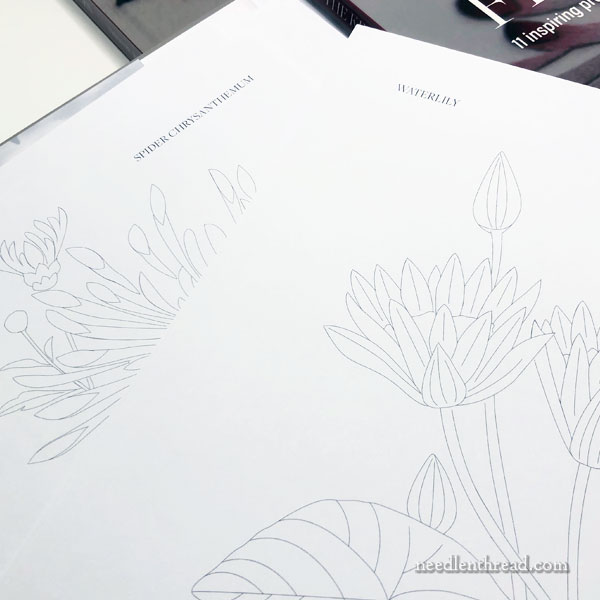
…a packet of iron-on transfers, to make your journey into the projects much easier!

The hard-board folio cover for that protects the book and the transfers closes with an elastic band, as shown above. It’s a lot like a moleskine notebook… a very large moleskine notebook.
The folio cover and the presence of iron-on transfers are probably the greatest differences you’ll notice right away with this book, but there are other nuances within the book itself that are slightly different from Trish’s previous books.

You might not notice it right off the bat, because many art and craft books these days have morphed into this approach, but some of the photos in here are larger than life.
They are big, making it easy to see the details of the embroidery.

I mean big-big!
This little berry element, for example, which is part of the Floral Sampler found under Simple Projects, is about 1.5″ high from the tip of the stem to the base of the berry when transferred at the given size.
In the book, the photo of the berry is around 5.5 – 6″ from tip of stem to base of berry. So it’s super enlarged, and you can’t miss the details!
This is a good thing, I think. Seeing details is helpful when it comes to exploring a technique, especially as a beginner.
But it can give you a sense of discombobulation when you set about embroidering. You don’t necessarily realize that the item you’re about to embroider is significantly smaller than the image of it, until you transfer it. This is one of the problems I run into with blogging, too. Close-up photos of embroidery shown on a website tend to give the sense that the piece is much larger than it actually is, and when you sit down to stitch it, there’s a period of adjustment while you get used to the difference in the real size versus the perceived size.
Still, I’d rather have too much detail than too little, especially when I’m learning something new!

Ok, let’s look at what’s in the book!
The Kew book is both an instructional book and a project book. The projects range from simple to advanced. If you are a beginner in needlepainting, you can start at the beginning of the book to get your feet wet, and then move into deeper waters. If you are experienced, you can jump in anywhere.
At the beginning of the book, you’ll find introductions to Kew, to Trish and the book’s contents, and to needlepainting in general.
Before getting into the projects, you’ll find the background information for getting started, from fabrics, threads, tools, and basic techniques.

Much of the preliminary instruction is offered via diagrams and via close-up photos that demonstrate the techniques.
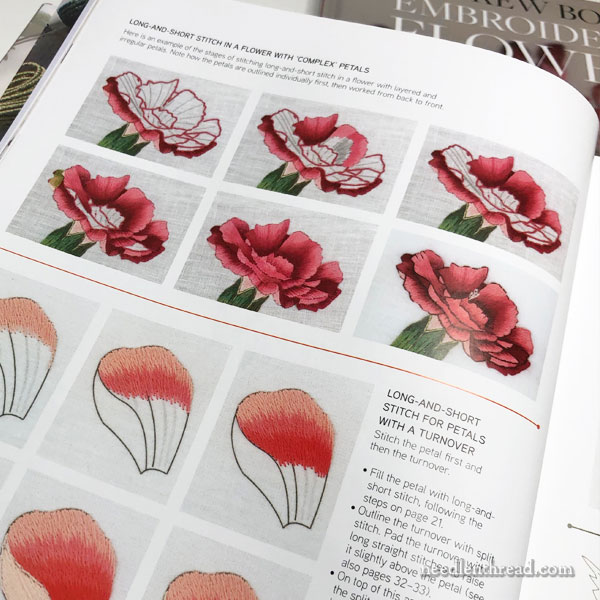
It’s all very clear, as you would expect.

Trish goes into great detail demonstrating approaches to shading, to color combinations, stitch direction, and so forth.
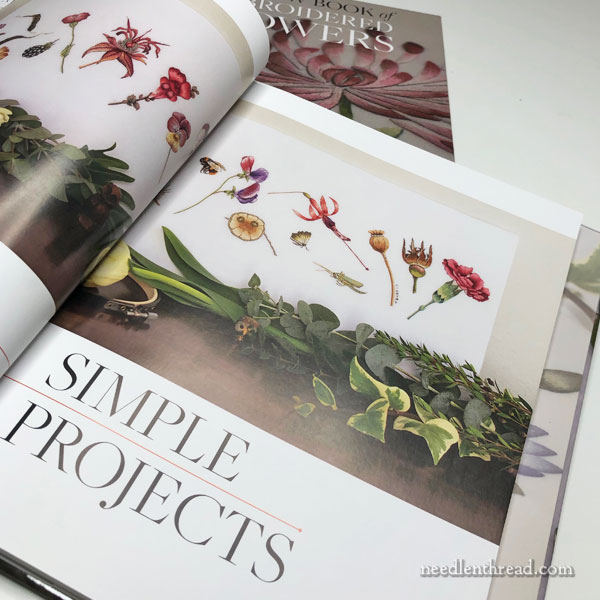
The are “11 inspiring projects” within the book… technically. Really, there are 28.
There are two projects in the book that really excite me the most, although they are all beautiful in their own way.
The first is under “Simple Projects,” and it’s called the “Flower Sampler.” It encompasses 18 embroidered elements (20, if you count each individual embroidered element), each of which can be taken out of sampler context and used as its own little practice project.
I love this sampler. I love the idea of it. I love the beauty of the finished, whole sampler. And I love the fact that each element could really stand on its own as a mini project.
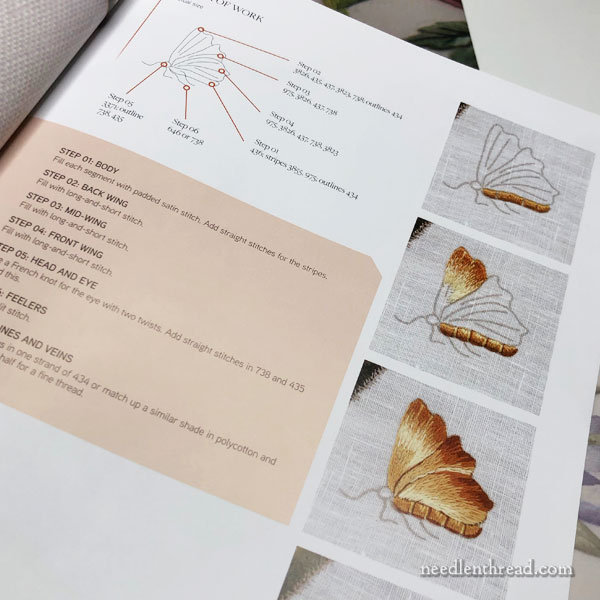
For each element in the sampler – some of which are not necessarily flowers – you get a materials list, the design, and step-by-step instructions on how to stitch it. You’ll also get a larger-than-life photo with clear details of the embroidery, which will serve well to help you successfully stitch your version.

There’s a magnificent bee, by the way…
Now, this is where Trish’s artistry really shines. I mean, it shines everywhere, but I’m especially besotted with this bee.
Check out that bee wing. It’s solidly embroidered. There’s no translucent anything there – the threads are solid colors. But is not that wing a wonder to behold? It looks translucent, thanks to her subtle shading, drawing in the colors behind the wing and bringing them to the forefront while stitching it.
It’s fabulous!
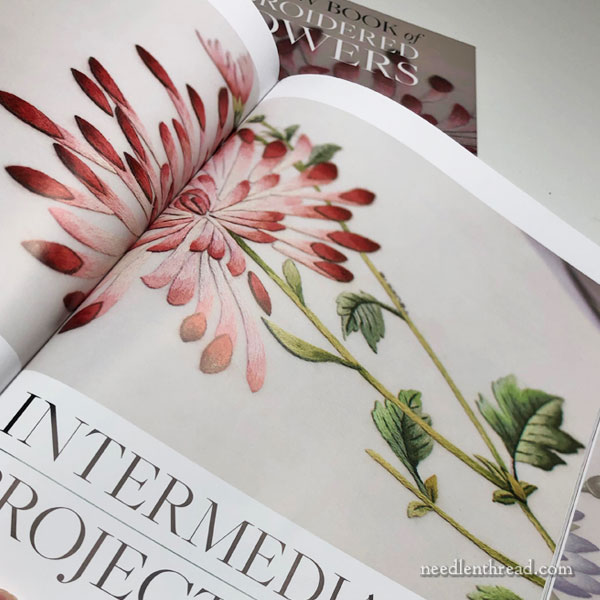
There are many simple projects in the book, then, if you consider the sampler as individual projects, too.
Then, there are intermediate projects that build on the knowledge and skills you’ve gleaned from the first section of the book. There are four intermediate projects, including studies of the rhododendron, the waterlily, the iris, and the spider chrysanthemum which graces the cover of the book.

For those of you who have followed Trish for years, you’ll probably notice some slight adjustments in her style and approach here and there throughout the book.
This rhododendron, for example, has a definite contemporary and somewhat trendy look to it. So you can expect to see some variation in Trish’s interpretations – they are not necessarily all sketchy-botanical looking. Some pieces are very boldly contemporary.
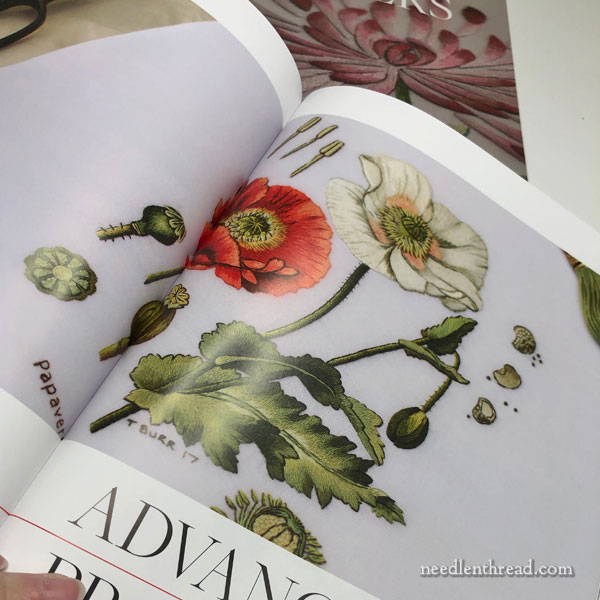
There are three advanced projects: a rose, a magnolia, and a poppy sampler.
That poppy sampler is my second favorite in the book! It’s just lovely. And it would be a wonderful study in long and short shading.
(I think I have A Thing for things called “samplers.”)
The poppy sampler can also be broken down into at least two – if not more – projects.

In the more advanced projects, you’ll see that Au Ver a Soie silks enter into the materials lists. Yay! I’m a huge fan of needlepainting with silk. I know there is a school of thought out there that favors stranded cotton for needlepainting (also called “silk shading”) but I’ve always thought that there’s nothing quite as beautiful as silk shading worked with silk!

In the back of the book, Trish offers a list of thread substitutions for those who wish to work some of the projects in silk. This is handy! Thread substitutions are never absolutely exact, but it’s a nice springboard for those who like to adjust their own color palettes and thread types.

Finally, of course, there’s the pattern section.
If you have the folio edition of the book, though, thankfully, you won’t have to go through a meticulous transfer process! Wow! Heaven!
What’s Not to Like?
I’m not going to pro and con this book. If you love needlepainting, if you want to explore needlepainting fully, if you love botanicals, you’re going to love this book. You’re going to want the special folio edition. And you’ll find it a treasure.
Where to Find It
If you’re in the US, you can pre-order the book now and be among the first to have it in July when it comes out. You’ll find it listed here under “Browse My Amazon Recommendations” on my Amazon page. It is an excellent value, considering you’re getting the book encased in a nice folio cover with the whole set of reusable (up to about three times) iron-on transfers.
Worldwide with free shipping, you can find the book available here through Book Depository, due to be released in just a week or so. Pretty much, the book is hitting the market in the US and worldwide right around the same time.
If you’re in Australia, the book is available through Create in Stitch, too. It may or may not be less expensive, depending on the exchange rate and shipping, for Australian shoppers – but it definitely will arrive faster! It doesn’t hurt to crunch the numbers, though.
This article contains affiliate links to some book sources, which means that Needle ‘n Thread receives a small commission for products purchased through those links at no extra cost to you. Thanks!







If you are in the UK, you can also buy this lovely book from Search Press, which is handy.
This is just beautiful, thank you for giving us a peek inside.
Being able to ‘leaf through’ this type of book ahead of purchase is so important, and in this case it has definitely made me feel I just have to buy it asap.
Embroidered insects often feel a bit creepy to me, but that bee is gorgeous, I am already mentally embroidering it as I type!
Thanks again for sharing and a Happy Monday to you too.
THANK you. This book is delish and I just pre-ordered my copy.
Ohhh Mary, Mary! What a book! I’ve been waiting for you to review this and yes … you’ve done it to me again … there will definitely be room made on my bookshelf for this beauty! 🙂 I love the samplers as well, I like the botanical approach showing different stages of the flower life cycle with the Poppy sampler. It has a similar style to a blue floral sampler which Trish released as a single pattern a while ago, and which is also on my wishlist. I see them together as a coordinating pair in my minds eye. Hmmm … thank you Mary for your thorough review, I am looking forward to ordering mine now. 🙂
Fabulous book finally came today! Thanks for the recommendation
I saw comments on Amazon that the transfers don’t transfer well enough to make an impression and the some of the instructions are not detailed enough even for experienced embroiderers. Otherwise, a beautiful book. On the fence about ordering.
Liz
I have tried these, and they do work, as long as you follow the basic rules of iron-ons: pin, pin, pin! (You don’t want the thing shifting!) Heat and pressure…
Of course, it does depend on the fabric you use. If you’re using a rougher fabric, or something with an open weave, or a darker fabric other than white / off white, you’ll never get as good a transfer as you would if using a fabric with a close weave and a smooth hand and a lighter color.